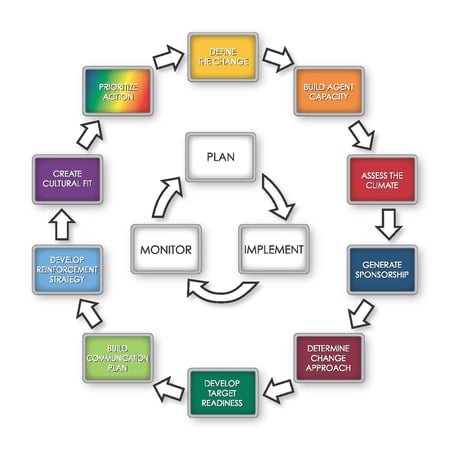Business changes come in all sizes. Some are limited to a few small, procedural modifications while others will completely transform your organization. But no matter what size change you are working on, employing a structured change management methodology is key if you want to ensure return on investment. 
The Value of Change Management
Unfortunately, when most people hear the term “change management” they automatically begin thinking:
- Change management is a “nice to have” but it is not really a necessity
- Change management is just another process that will slow my project down
- Of course, we are doing change management, that will happen at the end of the project and then we will check it off the to do list
Almost everyone understands the business value in using a disciplined project management protocol. Whether you are using Agile or the more traditional Waterfall approach, project management ensures a project is delivered on time, on budget and to scope. But that is not enough!
Contrary to popular belief, the greatest risk for failure or sub-optimization of an implementation is actually on the human side of the equation, not the technical side. So, if change management is defined as the rigor and discipline on the people side of a change, then without it, benefit realization is at risk.
The fact is, every organization can become better and faster at implementing change by applying the same amount of process, discipline, and rigor to the people side of the change as they do to the technical side.
The AIM Change Management Methodology
I developed the AIM Change Management methodology with this concept in mind. When you look at the 10 core change management principles depicted in AIM’s road map, you will see they surround the project management elements of Plan, Implement and Monitor. In AIM, the human elements of a project are meant to be blended with the project management approach from the very beginning. 
The principles of AIM are depicted in a cyclical road map, but the goal of change management, or what I prefer to call “implementation management,” shouldn’t be "to do" AIM, but rather to have these core principles guide you on what you should be doing, given the project’s day to day realities and challenges.
The 10 core principles in AIM are:
- Define the Change - Stakeholders need to have a commonly held definition of both the present state and the desired future state.
- Build Change Agent Capacity - Implementation success requires the right number of change agents, with the right skills, traits, and characteristics, located in the right places.
- Assess the Climate - No change occurs in isolation; it occurs in a context of all those priorities competing for resources and is impacted by organizational stress and past implementation history and cultural patterns.
- Generate Sponsorship - Committed Sponsorship is the single most important factor in ensuring swift and successful implementation. The priority is always to develop the cascade of Sponsors that individually and collectively demonstrate commitment by what they express, model and reinforce.
- Determine the Change Approach - Change Agents must be ambidextrous. Use a “hammer” for compliance changes and use transition management for commitment-based changes where you need to win over “hearts and minds.”
- Develop Target Readiness - Resistance to change is inevitable. It must be managed. It cannot be denied, discounted, deferred to, or defeated.
- Build Communication Plan - You must communicate in the Frame of Reference of each Target, with a built-in feedback loop for every communication so you can check for understanding and identify sources of resistance.
- Develop Reinforcement Strategy - There is no change unless there is behavior change, and there is no behavior change without a change in reinforcement. You are either reinforcing the change, or reinforcing the status-quo.
- Create Cultural Fit - If your project conflicts with the current culture, culture wins unless you are significantly altering the reinforcements.
- Prioritize Action - You must blend the technical side and the human side of project management.
Change Management is not a commodity that can be purchased and completed. It is not checklists, slide decks or simply a communication plan. And it is definitely not something you can check off of your to do list. Change management is project management for the human side of a project. By integrating change management into project management protocols, project managers will have the tools to manage the human objectives of the change with the same level of rigor as applied to the technical objectives leading to successful implementations…at speed. How are you leading people through your organizational changes?


